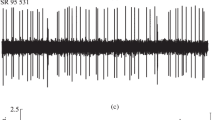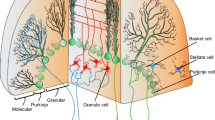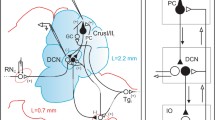Abstract
The activity of cerebellar Purkinje cells is studied as affected by CyPPA, a positive modulator of small-conductance calcium-activated potassium channels type 3 and 2 (SK3/SK2), and NS309, an activator of small- and intermediate-conductance calcium-activated potassium channels (IK/SK), in male two-month-old laboratory mice. CyPPA decreases the simple spike firing frequency in the discharge of Purkinje cells by an average of 25% 1 hour after application of 1mM of the compound. An application of 100 μM of NS309 reduces the simple spike firing frequency by an average of 47% during the same period. These results confirm the hypothesis that SK channels may be involved in the downregulation of simple spike firing frequency in Purkinje cells. The frequency-regulating effect of NS309 is stronger, suggesting that IK/SK channels play a decisive role in the regulation of Purkinje cell spiking activity. Since an increase of simple spike firing frequency in these cells is symptomatic of many locomotor activity disorders, e.g., spinocerebellar ataxia, the substances studied or their functional analogues might be of medicinal interest.
Similar content being viewed by others
References
Ferin, M., Grigorian, R.A., and Strata, P., Mossy and climbing fibre activation in the cat cerebellum by stimulation of the labyrinth, Exp. Brain. Res., 1971, vol. 12, no. 1, pp. 1–17.
Tong, G., Robertson, L.T., and Brons, J., Climbing fiber representation of the renal afferent nerve in the vermal cortex of the cat cerebellum, Brain. Res., 1993, vol. 601, nos. 1–2, pp. 65–75.
Cerminara, N.L., Edge, A.L., Marple-Horvat, D.E., and Apps, R., The lateral cerebellum and visuomotor control, Prog. Brain. Res., 2005, vol. 148, pp. 213–226.
Fanardzhan, V.V. and Kazaryan, L.L., On the local and diffuse projection of afferent systems to the cerebellar cortex, Fiziol. Zh. SSSR, 1970, vol. 56, pp. 1523–1530.
Ito, M., The Cerebellum and Neuronal Control, New York: Raven, 1984.
Cerminara, N.L. and Rawson, J.A., Evidence that climbing fibers control an intrinsic spike generator in cerebellar Purkinje cells, J. Neurosci., 2004, vol. 24, no. 19, pp. 4510–4517.
Ito, M., Cerebellar long-term depression: characterization, signal transduction, and functional roles, Physiol. Rev., 2001, vol. 81, no. 3, pp. 1143–1195.
Grigoryan, R.A., Zernova, G.V., and Khorkov, A.D., The action of small doses of ethanol on Purkinje cell activity in mouse cerebellum, Dokl. Akad. Nauk SSSR, 1992, vol. 325, no. 4, pp. 865–868.
Raman, I.M. and Bean, B.P., Ionic currents underlying spontaneous action potentials in isolated cerebellar Purkinje neurons, J. Neurosci., 1999, vol. 19, no. 5. pp. 1663–1674.
Carlson, K.M., Andresen, J.M., and Orr, H.T., Emerging pathogenic pathways in the spinocer ebellar ataxias, Curr. Opin. Genet. Dev., 2009, vol. 19, no. 3, pp. 247–253.
Walter, J.T., Alvina, K., Womack, M.D., Chevez, C., and Khodakhah, K., Decreases in the precision of Purkinje cell pacemaking cause cerebellar dysfunction and ataxia, Nat. Neurosci., 2006, vol. 9, no. 3, pp. 389–397.
Kasumu, A.W., Hougaard, C., Rode, F., Jacobsen, T.A., Sabatier, J.M., Eriksen, B.L., Strøbæk, D., Liang, X., Egorova, P., Vorontsova, D., Christophersen, P., Rønn, L.C.B., and Bezprozvanny, I., Selective positive modulator of calcium-activated potassium channels exerts beneficial effects in a mouse model of spinocerebellar ataxia type 2, Chemistry and Biology, 2012, vol. 19, no. 10, pp. 1340–1353.
Karelina, T.V. and Grigoryan, R.A., Effect of harmaline on the complex spike shape and depression time in cerebellar Purkinje cell discharge in rat postnatal ontogenesis, J. Evol. Biochem. Physiol., 2010, vol. 46, pp. 259–266.
Gao, Z., Todorov, B., Barrett, C.F., van Dorp, S., Ferrari, M.D., van den Maagdenberg, A.M., De Zeeuw, C.I., and Hoebeek, F.E., Cerebellar ataxia by enhanced Ca(V)2.1 currents is alleviated by Ca2+-dependent K+-channel activators in Cacna1a(S218L) mutant mice, J. Neurosci., 2012, vol. 32, no. 44, pp. 15 533–15 546.
Sailer, C.A., Hu, H., Kaufmann, W.A., Trieb, M., Schwarzer, C., Storm, J.F., and Knaus, H.G., Regional differences in distribution and functional expression of small-conductance Ca2+-activated K+ channels in rat brain, J. Neurosci., 2002, vol. 22, no. 22, pp. 9698–9707.
Womack, M.D. and Khodakhah, K., Somatic and dendritic small-conductance calcium-activated potassium channels regulate the output of cerebellar Purkinje neurons, J. Neurosci., 2003, vol. 23, no. 7, pp. 2600–2607.
Kasumu, A.W., Liang, X., Egorova, P., Vorontsova, D., and Bezprozvanny, I., Chronic suppression of inositol 1,4,5-triphosphate receptor-mediated calcium signaling in cerebellar Purkinje cells alleviates pathological phenotype in spinocerebellar ataxia 2 mice, J. Neurosci., 2012, vol. 32, no. 37, pp. 12 786–12 796.
Shakkottai, V.G., Do Carmo Costa, M., Dell’Orco, J.M., Sankaranarayanan, A., Wulff, H., and Paulson, H.L., Early changes in cerebellar physiology accompany motor dysfunction in the polyglutamine disease, spinocerebellar ataxia type 3, J. Neurosci., 2011, vol. 31, no. 36, pp. 13 002–1 3014.
Hougaard, C., Eriksen, B. L., Jørgensen, S., Johansen, T.H., Dyhring, T., Madsen, L.S., Strøbaek, D., and Christophersen, P., Selective positive modulation of the SK3 and SK2 subtypes of small conductance Ca2+-activated K+ channels, Br. J. Pharmacol., 2007, vol. 151, no. 5, pp. 655–665.
Author information
Authors and Affiliations
Corresponding author
Additional information
Original Russian Text © P.A. Egorova, T.V. Karelina, O.L. Vlasova, S.M. Antonov, I.B. Bezprozvanny, 2014, published in Zhurnal Evolyutsionnoi Biokhimii i Fiziologii, 2014, Vol. 50, No. 2, pp. 102–108.
Rights and permissions
About this article
Cite this article
Egorova, P.A., Karelina, T.V., Vlasova, O.L. et al. The effect of SK channel modulators on the simple spike firing frequency in discharge of cerebellar Purkinje cells in laboratory mice. J Evol Biochem Phys 50, 114–120 (2014). https://doi.org/10.1134/S0022093014020045
Received:
Published:
Issue Date:
DOI: https://doi.org/10.1134/S0022093014020045




